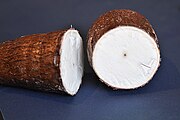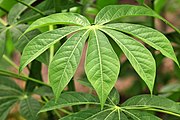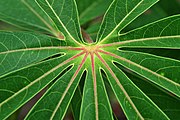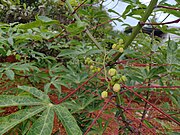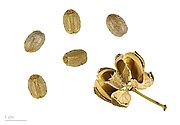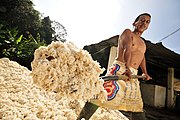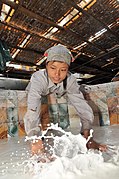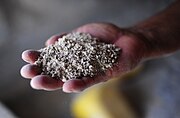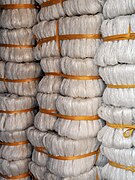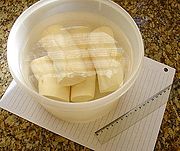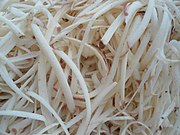| Cassava | |
|---|---|
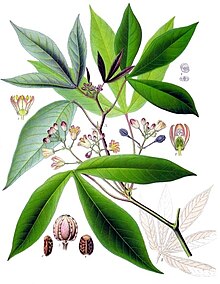
| |

| |
| Tuber (waxed) | |
|
Scientific classification
| |
| Kingdom: | Plantae |
| Clade: | Tracheophytes |
| Clade: | Angiosperms |
| Clade: | Eudicots |
| Clade: | Rosids |
| Order: | Malpighiales |
| Family: | Euphorbiaceae |
| Genus: | Manihot |
| Species: | M. esculenta
|
| Binomial name | |
| Manihot esculenta | |
| Synonyms [1] | |
| |
Manihot esculenta, commonly called cassava, manioc, or yuca (among numerous regional names), is a woody shrub of the spurge family, Euphorbiaceae, native to South America, from Brazil, Paraguay and parts of the Andes. Although a perennial plant, cassava is extensively cultivated in tropical and subtropical regions as an annual crop for its edible starchy root tuber. Cassava is predominantly consumed in boiled form, but substantial quantities are processed to extract cassava starch, called tapioca, which is used for food, animal feed, and industrial purposes. The Brazilian farinha, and the related garri of West Africa, is an edible coarse flour obtained by grating cassava roots, pressing moisture off the obtained grated pulp, and finally drying it (and roasting in the case of both farinha and garri).
Cassava is the third-largest source of carbohydrates in food in the tropics, after rice and maize, making it is an important staple; more than 500 million people depend on it. It offers the advantage of being exceptionally drought-tolerant, and able to grow productively on poor soil. The largest producer is Nigeria, while Thailand is the largest exporter of cassava starch.
Cassava is grown in sweet and bitter varieties; both contain toxins, but the bitter varieties have them in much larger amounts. Cassava has to be prepared carefully for consumption, as improperly prepared material can contain sufficient cyanide to cause poisoning. The more toxic varieties of cassava have been used in some places as famine food during times of food insecurity. Farmers may however choose bitter cultivars to minimise crop losses.
Description
The harvested part of a cassava plant is the root. This is long and tapered, with an easily detached rough brown rind. The white or yellowish flesh is firm and even in texture. Commercial cultivars can be 5 to 10 centimetres (2 to 4 in) wide at the top, and some 15 to 30 cm (6 to 12 in) long, with a woody vascular bundle running down the middle. The roots are largely starch, with small amounts of calcium (16 milligrams per 100 grams), phosphorus (27 mg/100 g), and vitamin C (20.6 mg/100 g). [2] Cassava roots contains little protein, whereas the leaves are rich in protein, [3] except for being low in methionine, an essential amino acid. [4]
-
Cassava plant
-
Unprocessed tubers
-
Tuber in cross-section
-
Leaf
-
Leaf detail
-
Flower buds
-
Seeds
Genome
The complete and haplotype-resolved African cassava (TME204) genome has been reconstructed and made available using the Hi-C technology. [5] The genome shows abundant novel gene loci with enriched functionality related to chromatin organization, meristem development, and cell responses. [5] Differentially expressed transcripts of different haplotype origins were enriched for different functionality during tissue development. In each tissue, 20–30% of transcripts showed allele-specific expression differences with <2% of direction-shifting. Despite high gene synteny, the HiFi genome assembly revealed extensive chromosome rearrangements and abundant intra-genomic and inter-genomic divergent sequences, with significant structural variations mostly related to long terminal repeat retrotransposons. [5]
Although smallholders are otherwise economically inefficient producers, they are vital to productivity at particular times. [6] Small cassava farmers are no exception. [6] Genetic diversity is vital when productivity has declined due to pests and diseases, and smallholders tend to retain less productive but more diverse gene pools. [6]
MeFT1 (FT) is a gene producing FT proteins which affect the formation of storage roots in many plants, including this one. [7] Alleles in cassava include MeFT1 and MeFT2. [7] MeFT1 expression in leaves seems to not be photoperiodic, while MeFT2 clearly is. [7] MeFT1 expression encourages motivation of sucrose towards the reproductive organs, as shown by experimental overexpression reducing storage root accumulation. [7]
History
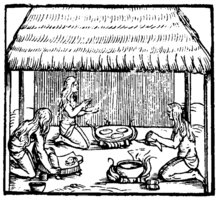
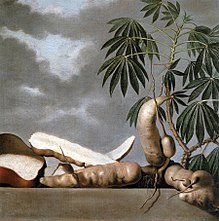
Wild populations of M. esculenta subspecies flabellifolia, shown to be the progenitor of domesticated cassava, are centered in west-central Brazil, where it was likely first domesticated no more than 10,000 years ago. [8] Forms of the modern domesticated species can also be found growing in the wild in the south of Brazil. By 4600 BC, cassava pollen appears in the Gulf of Mexico lowlands, at the San Andrés archaeological site. [9] The oldest direct evidence of cassava cultivation comes from a 1,400-year-old Maya site, Joya de Cerén, in El Salvador. [10] It became a staple food of the native populations of northern South America, southern Mesoamerica, and the Taino people in the Caribbean islands, who grew it using a high-yielding form of shifting agriculture by the time of European contact in 1492. [11] Cassava was a staple food of pre-Columbian peoples in the Americas and is often portrayed in indigenous art. The Moche people often depicted yuca in their ceramics. [12]
Spaniards in their early occupation of Caribbean islands did not want to eat cassava or maize, which they considered insubstantial, dangerous, and not nutritious. They much preferred foods from Spain, specifically wheat bread, olive oil, red wine, and meat, and considered maize and cassava damaging to Europeans. [13] The cultivation and consumption of cassava were nonetheless continued in both Portuguese and Spanish America. Mass production of cassava bread became the first Cuban industry established by the Spanish. [14] Ships departing to Europe from Cuban ports such as Havana, Santiago, Bayamo, and Baracoa carried goods to Spain, but sailors needed to be provisioned for the voyage. The Spanish also needed to replenish their boats with dried meat, water, fruit, and large amounts of cassava bread. [15] Sailors complained that it caused them digestive problems. [16]
Portuguese traders introduced cassava to Africa from Brazil in the 16th century. Around the same period, it was also introduced to Asia through Columbian Exchange by Portuguese and Spanish traders, who planted it in their colonies in Goa, Malacca, Eastern Indonesia, Timor and the Philippines. [17] Cassava has also become an important crop in Asia. While it is a valued food staple in parts of eastern Indonesia, it is primarily cultivated for starch extraction and bio-fuel production in Thailand, Cambodia and Vietnam. [18] Cassava is sometimes described as the "bread of the tropics" [19] but should not be confused with the tropical and equatorial bread tree (Encephalartos), the breadfruit (Artocarpus altilis) or the African breadfruit (Treculia africana). This description definitely holds in Africa and parts of South America; in Asian countries such as Vietnam fresh cassava barely features in human diets. [20]
There is a legend that cassava was introduced in 1880–1885 CE to the South Indian state of Kerala by the King of Travancore, Vishakham Thirunal Maharaja, after a great famine hit the kingdom, as a substitute for rice. [21] However, there are documented cases of cassava cultivation in parts of the state before the time of Vishakham Thirunal Maharaja. [22] Cassava is called kappa or maricheeni in Malayalam, and tapioca in Indian English usage. [23]
Cultivation
Optimal conditions for cassava cultivation are: mean annual temperatures between 20 and 29 °C (68 and 84 °F), annual precipitation between 1,000 and 2,500 mm (39 and 98 in), and an annual growth period of no less than 240 days. [24] Cassava is propagated by cutting the stem into sections of approximately 15 cm (5.9 in), these being planted prior to the wet season. [25] Cassava growth is favorable under temperatures ranging from 25 to 29 °C (77 to 84 °F), but it can tolerate temperatures as low as 12 °C (54 °F) and as high as 40 °C (104 °F). [26] These conditions are found, among other places, in the northern part of the Gulf Coastal Plain in Mexico. [24] In this part of Mexico the following soil types have been shown to be good for cassava cultivation: phaeozem, regosol, arenosol, andosol and luvisol. [24]
-
Stakes
Pests

Cassava is subject to pests from multiple taxonomic groups, including viruses, bacteria, fungi, nematodes, and insects. All cause reductions in yield, and some cause serious losses of crops. [27]
- Viruses
Several viruses cause enough damage to cassava crops to be of economic importance. The African cassava mosaic virus causes the leaves of the cassava plant to wither, limiting the growth of the root. [28] An outbreak of the virus in Africa in the 1920s led to a major famine. [29] The virus is spread by the whitefly and by the transplanting of diseased plants into new fields. Sometime in the late-1980s, a mutation occurred in Uganda that made the virus even more harmful, causing the complete loss of leaves. This mutated virus spread at a rate of 80 kilometres (50 miles) per year, and as of 2005 was found throughout Uganda, Rwanda, Burundi, the Democratic Republic of the Congo and the Republic of the Congo. [30] Viruses are a severe production limitation in the tropics. They are the primary reason for the complete lack of yield increases in the 25 years up to 2021 [update]. [31] Cassava brown streak virus disease is a major threat to cultivation worldwide. [29] Cassava mosaic virus (CMV) is widespread in Africa, causing cassava mosaic disease (CMD). [32] Bredeson et al. 2016 find the M. esculenta cultivars most widely used on that continent have M. carthaginensis subsp. glaziovii genes of which some appear to be CMD resistance genes. [32] Although the ongoing CMD pandemic affects both East and Central Africa, Legg et al. found that these two areas have two distinct subpopulations of the vector, Bemisia tabaci whiteflies. [33] [34] Genetically engineered cassava offers opportunities for the improvement of virus resistance, including CMV and CBSD resistance. [35]
- Bacteria
Among the most serious bacterial pests is Xanthomonas axonopodis pv. manihotis, which causes bacterial blight of cassava. This disease originated in South America and has followed cassava around the world. [36] Bacterial blight has been responsible for near catastrophic losses and famine in past decades, and its mitigation requires active management practices. [36] Several other bacteria attack cassava, including the related Xanthomonas campestris pv. cassavae, which causes bacterial angular leaf spot. [37]
- Fungi
Several fungi bring about significant crop losses, one of the most serious being cassava root rot; the pathogens involved are species of Phytophthora, the genus which causes potato blight. Cassava root rot can result in losses of as much as 80 percent of the crop. [27] A major pest is a rust caused by Uromyces manihotis. [38] Superelongation disease, caused by Elsinoë brasiliensis, can cause losses of over 80 percent of young cassava in Latin America when temperature and rainfall are high. [27]
- Nematodes
Nematode pests of cassava are thought to cause harms ranging from negligible to seriously damaging, [39] [40] [41] making the choice of management methods difficult. [42] A wide range of plant parasitic nematodes have been reported associated with cassava worldwide. These include Pratylenchus brachyurus, Rotylenchulus reniformis, Helicotylenchus spp., Scutellonema spp. and Meloidogyne spp., of which Meloidogyne incognita and Meloidogyne javanica are the most widely reported and economically important. [43] Meloidogyne spp. feeding produces physically damaging galls with eggs inside them. Galls later merge as the females grow and enlarge, and they interfere with water and nutrient supply. [41] Cassava roots become tough with age and restrict the movement of the juveniles and the egg release. It is therefore possible that extensive galling can be observed even at low densities following infection. [42] Other pests and diseases can gain entry through the physical damage caused by gall formation, leading to rots. They have not been shown to cause direct damage to the enlarged storage roots, but plants can have reduced height if there was loss of enlarged root weight. [44] Nematicides reduce the numbers of galls per feeder root, along with fewer rots in the storage roots. [45] The organophosphorus nematicide femaniphos does not reduce crop growth or harvest yield. Nematicide use in cassava is not terribly effective at increasing harvested yield, but lower infestation at harvest and lower subsequent storage loss provide a higher effective yield. The use of tolerant and resistant cultivars is the most practical management method in most locales. [46] [42] [47]
- Insects

Insects such as stem borers and other beetles, moths including Chilomima clarkei, scale insects, fruit flies, shootflies, burrower bugs, grasshoppers, leafhoppers, gall midges, leafcutter ants, and termites contribute to losses of cassava in the field, [27] while others contribute to serious losses, between 19% and 30%, of dried cassava in storage. [48] In Africa, a previous issue was the cassava mealybug ( Phenacoccus manihoti) and cassava green mite ( Mononychellus tanajoa). These pests can cause up to 80 percent crop loss, which is extremely detrimental to the production of subsistence farmers. These pests were rampant in the 1970s and 1980s but were brought under control following the establishment of the Biological Control Centre for Africa of the International Institute of Tropical Agriculture (IITA) under the leadership of Hans Rudolf Herren. [49] The Centre investigated biological control for cassava pests; two South American natural enemies Anagyrus lopezi (a parasitoid wasp) and Typhlodromalus aripo (a predatory mite) were found to effectively control the cassava mealybug and the cassava green mite, respectively. [50]
Harvesting
Before harvest, the leafy stems are removed. The harvest is gathered by pulling up the base of the stem and cutting off the roots. [25]
Handling and storage
Cassava deteriorates after harvest, when the tubers are first cut. The healing mechanism produces coumaric acid, which oxidizes and blackens the tubers, making them inedible after a few days. This deterioration is related to the accumulation of reactive oxygen species initiated by cyanide release during mechanical harvesting. Cassava shelf life may be increased up to three weeks by overexpressing a cyanide-insensitive alternative oxidase, which suppressed ROS by 10-fold. [51] Post-harvest deterioration is a major obstacle to the export of cassava. Fresh cassava can be preserved like potato, using thiabendazole or bleach as a fungicide, then wrapping in plastic, freezing, or applying a wax coating. [52]
While alternative methods for controlling post-harvest deterioration have been proposed, such as preventing reactive oxygen species effects by using plastic bags during storage and transport, coating the roots with wax, or freezing roots, such strategies have proved to be economically or technically impractical, leading to breeding of cassava varieties with improved durability after harvest, achieved by different mechanisms. [53] [53] [54] One approach used gamma rays to try to silence a gene involved in triggering deterioration; another strategy selected for plentiful carotenoids, antioxidants which may help to reduce oxidization after harvest. [54]
-
Starch processing
-
Starch flour
-
Starch wet-processing
-
Starch
-
Spreading Casabe burrero (cassava bread) to dry, Venezuela
-
Starch being prepared for packaging
-
Starch noodles packaged for shipping
-
Frozen leaves in a Los Angeles market
-
Picked buds
Production
| Cassava production – 2022 | |
|---|---|
| Country | millions of tonnes |
| 60.8 | |
| 48.8 | |
| 34.1 | |
| 25.6 | |
| 17.7 | |
| 17.6 | |
| World | 330 |
| Source: FAOSTAT of the United Nations [55] | |
In 2022, world production of cassava root was 330 million tonnes, led by Nigeria with 18% of the total (table). Other major growers were Democratic Republic of the Congo and Thailand.
Cassava is the third-largest source of carbohydrates in food in the tropics, after rice and maize. [56] [57] [31] making it is an important staple; more than 500 million people depend on it. [58] It offers the advantage of being exceptionally drought-tolerant, and able to grow productively on poor soil. Cassava grows well within 30° of the equator, where it can be produced at up to 2,000 m (7,000 ft) above sea level, and with 50 to 5,000 mm (2 to 200 in) of rain per year. These environmental tolerances suit it to conditions across much of South America and Africa. [59]
Cassava yields a large amount of food energy per unit area of land per day – 1,000,000 kJ/ha (250,000 kcal/ha), as compared with 650,000 kJ/ha (156,000 kcal/ha) for rice, 460,000 kJ/ha (110,000 kcal/ha) for wheat and 840,000 kJ/ha (200,000 kcal/ha) for maize. [60]
Cassava, yams ( Dioscorea spp.), and sweet potatoes (Ipomoea batatas) are important sources of food in the tropics. The cassava plant gives the third-highest yield of carbohydrates per cultivated area among crop plants, after sugarcane and sugar beets. [61] Cassava plays a particularly important role in agriculture in developing countries, especially in sub-Saharan Africa, because it does well on poor soils and with low rainfall, and because it is a perennial that can be harvested as required. Its wide harvesting window allows it to act as a famine reserve and is invaluable in managing labor schedules. It offers flexibility to resource-poor farmers because it serves as either a subsistence or a cash crop. [62] Worldwide, 800 million people depend on cassava as their primary food staple. [63]
Toxicity
Cassava roots, peels and leaves are dangerous to eat raw because they contain linamarin and lotaustralin, which are toxic cyanogenic glycosides. These are decomposed by the cassava enzyme linamarase, releasing poisonous hydrogen cyanide. [64] Cassava varieties are often categorized as either bitter (high in cyanogenic glycosides) or sweet (low in those bitter compounds). Sweet cultivars can contain as little as 20 milligrams of cyanide per kilogram of fresh roots, whereas bitter cultivars may contain as much as 1000 milligrams per kilogram. Cassavas grown during drought are especially high in these toxins. [65] [66] A dose of 25 mg of pure cassava cyanogenic glucoside, which contains 2.5 mg of cyanide, is sufficient to kill a rat. [67] Excess cyanide residue from improper preparation causes goiters and acute cyanide poisoning, and is linked to ataxia (a neurological disorder affecting the ability to walk, also known as konzo). [68] It has also been linked to tropical fibrocalcific pancreatitis in humans, leading to chronic pancreatitis. [69] [70]
Symptoms of acute cyanide intoxication appear four or more hours after ingesting raw or poorly processed cassava: vertigo, vomiting, goiter, ataxia, partial paralysis, collapse, and death. [71] [72] [73] [74] It can be treated easily with an injection of thiosulfate (which makes sulfur available for the patient's body to detoxify by converting the poisonous cyanide into thiocyanate). [68]
Chronic, low-level exposure to cyanide may contribute to both goiter and tropical ataxic neuropathy, also called konzo, which can be fatal. The risk is highest in famines, when as many as 3 percent of the population may be affected. [75] [76]
Like many other roots and tubers, both bitter and sweet varieties of cassava contain antinutritional factors and toxins, with the bitter varieties containing much larger amounts. [68] The more toxic varieties of cassava have been used in some places as famine food during times of food insecurity. [71] [68] For example, during the shortages in Venezuela in the late 2010s, dozens of deaths were reported due to Venezuelans resorting to eating bitter cassava in order to curb starvation. [77] [78] Cases of cassava poisoning were also documented during the famine accompanying the Great Leap Forward (1958–1962) in China. [79] Farmers may select bitter cultivars to reduce crop losses. [80]
Societies that traditionally eat cassava generally understand that some processing (soaking, cooking, fermentation, etc.) is necessary to avoid getting sick. Brief soaking (four hours) of cassava is not sufficient, but soaking for 18–24 hours can remove up to half the level of cyanide. Drying may not be sufficient, either. [68]
For some smaller-rooted, sweet varieties, cooking is sufficient to eliminate all toxicity. The cyanide is carried away in the processing water and the amounts produced in domestic consumption are too small to have environmental impact. [64] The larger-rooted, bitter varieties used for production of flour or starch must be processed to remove the cyanogenic glucosides. The large roots are peeled and then ground into flour, which is then soaked in water, squeezed dry several times, and toasted. The starch grains that flow with the water during the soaking process are also used in cooking. [81] The flour is used throughout South America and the Caribbean. Industrial production of cassava flour, even at the cottage level, may generate enough cyanide and cyanogenic glycosides in the effluents to have a severe environmental impact. [64]
Uses
Food and drink
There are many ways of cooking cassava. [82] It has to be prepared correctly to remove its toxicity. [83] The root of the sweet variety is mild to the taste, like potatoes; Jewish households sometimes use it in cholent. [84] It can be made into a flour that is used in breads, cakes and cookies. In Brazil, farofa, a dry meal made from cooked powdered cassava, is roasted in butter, eaten as a side dish, or sprinkled on other food. [85]
Alcoholic beverages made from cassava include cauim (Brazil), [86] kasiri (Venezuela, Guyana, Suriname), [87] parakari or kari (Venezuela, Guyana, Surinam), [88] and nihamanchi (South America), [89]
-
Heavy cake
-
Bread
-
Noodles, Cambodia
Preparation of bitter cassava
A safe processing method known as the "wetting method" is to mix the cassava flour with water into a thick paste, spread it in a thin layer over a basket and then let it stand for five hours at 30 °C in the shade. [90] In that time, about 83% of the cyanogenic glycosides are broken down by the linamarase; the resulting hydrogen cyanide escapes to the atmosphere, making the flour safe for consumption the same evening. [90]
The traditional method used in West Africa is to peel the roots and put them into water for three days to ferment. The roots are then dried or cooked. In Nigeria and several other west African countries, including Ghana, Cameroon, Benin, Togo, Ivory Coast, and Burkina Faso, they are usually grated and lightly fried in palm oil to preserve them. The result is a foodstuff called garri. Fermentation is also used in other places such as Indonesia (see Tapai). The fermentation process also reduces the level of antinutrients, making the cassava a more nutritious food. [91] The reliance on cassava as a food source and the resulting exposure to the goitrogenic effects of thiocyanate has been responsible for the endemic goiters seen in the Akoko area of southwestern Nigeria. [92] [93]
-
Unprocessed roots
-
Tuber, peeled and soaking to reduce toxicity
A traditional method used by the Lucayans to detoxify cassava is by peeling, grinding, and mashing; filtering the mash through a basket tube to remove the hydrogen cyanide; and drying and sieving the mash for flour. The poisonous filtrate water was boiled to release the hydrogen cyanide, and used as a base for stews. [94]
Bioengineering has been applied to grow cassava with lower cyanogenic glycosides combined with fortification of vitamin A, iron and protein to improve the nutrition of people in sub-Saharan Africa. [95] [96]
In Guyana the traditional cassareep is made from bitter cassava juice. [97] The juice is boiled until it is reduced by half in volume, [98] to the consistency of molasses [99] and flavored with spices—including cloves, cinnamon, salt, sugar, and cayenne pepper. [100] Traditionally, cassareep was boiled in a soft pot, the actual "pepper pot", which would absorb the flavors and also impart them (even if dry) to foods such as rice and chicken cooked in it. [101] The poisonous but volatile hydrogen cyanide is evaporated by heating. [102] Nevertheless, improperly cooked cassava has been blamed for a number of deaths. [103] Amerindians from Guyana reportedly made an antidote by steeping chili peppers in rum. [99] The natives of Guyana traditionally brought the product to town in bottles, [104] and it is available on the US market in bottled form. [105]
Nutrition
| Nutritional value per 100 g (3.5 oz) | |
|---|---|
| Energy | 670 kJ (160 kcal) |
38.1 g | |
| Sugars | 1.7 g |
| Dietary fiber | 1.8 g |
0.3 g | |
1.4 g | |
| Vitamins | Quantity
%DV† |
| Thiamine (B1) | 7% 0.087 mg |
| Riboflavin (B2) | 4% 0.048 mg |
| Niacin (B3) | 5% 0.854 mg |
| Vitamin B6 | 5% 0.088 mg |
| Folate (B9) | 7% 27 μg |
| Vitamin C | 23% 20.6 mg |
| Minerals | Quantity
%DV† |
| Calcium | 1% 16 mg |
| Iron | 2% 0.27 mg |
| Magnesium | 5% 21 mg |
| Phosphorus | 2% 27 mg |
| Potassium | 9% 271 mg |
| Sodium | 1% 14 mg |
| Zinc | 3% 0.34 mg |
| Other constituents | Quantity |
| Water | 60 g |
| †Percentages estimated using US recommendations for adults, [106] except for potassium, which is estimated based on expert recommendation from the National Academies. [107] | |
Raw cassava is 60% water, 38% carbohydrates, 1% protein, and has negligible fat (table). [108] In a 100-gram (3+1⁄2-ounce) reference serving, raw cassava provides 670 kilojoules (160 kilocalories) of food energy and 23% of the Daily Value (DV) of vitamin C, but otherwise has no micronutrients in significant content (i.e. above 10% of the relevant DV). [108]
Biofuel
Cassava has been studied as a feedstock to produce ethanol as a biofuel. In the Eleventh Five-Year Plan in the People's Republic of China, a target for renewable energy was to increase the production of ethanol fuel from nongrain feedstock to 2 million metric tons (2,000,000 long tons; 2,200,000 short tons), and that of biodiesel to 200 thousand metric tons (200,000 long tons; 220,000 short tons) by 2010. This is equivalent to the replacement of 10 million metric tons (9,800,000 long tons; 11,000,000 short tons) of petroleum. [109] This push for non-grain ethanol was further increased to a goal of 300 million metric tons (300,000,000 long tons; 330,000,000 short tons) of cellulosic and non-grain based ethanol combined by 2020. [110] This has made cassava chips a major source of ethanol. In 2008, an ethanol fuel production facility in Beihai, able to produce 200 thousand metric tons (200,000 long tons; 220,000 short tons) annually, and requiring some 1.5 million metric tons (1,500,000 long tons; 1,700,000 short tons) of cassava, was opened. [111]
Animal feed
Cassava tubers and hay are used worldwide as animal feed. Young cassava hay is harvested at three to four month, when it reaches about 30 to 45 cm (12 to 18 in) above ground; it is dried in the sun until its dry matter content approaches 85 percent. The hay contains 20–27 percent protein and 1.5–4 percent tannin. It is valued as a source of roughage for ruminants such as cattle. [112]
-
Tubers being grated
-
A close-up of the product
-
Drying on road to be used for pig and chicken feed
Laundry starch
Cassava is used in laundry products, especially as starch to stiffen shirts and other garments. [113]
See also
- Abacha
- Attiéké – a side dish made from cassava that is a part of the cuisine of Côte d'Ivoire in Africa
- Columbian Exchange
- Couac
- Fufu
- Kwanga
- Kasiri
- Maní (Amazonian legend)
- Nihamanchi
- Tapioca industry of Thailand
- Yellow cassava
References
- ^ a b "Manihot esculenta Crantz, Rei Herb. 1: 167 (1766)". Plants of the World Online. Board of Trustees of the Royal Botanic Gardens, Kew. 2022. Archived from the original on 11 November 2022. Retrieved 11 November 2022.
- ^ "Basic Report: 11134, Cassava, raw". National Nutrient Database for Standard Reference Release 28. Agricultural Research Service, US Department of Agriculture. May 2016. Archived from the original on 12 July 2017. Retrieved 7 December 2016.
- ^ Latif, Sajid; Müller, Joachim (2015). "Potential of cassava leaves in human nutrition: a review". Trends in Food Science & Technology. 44 (2): 147–158. doi: 10.1016/j.tifs.2015.04.006.
- ^ Ravindran, Velmerugu (1992). "Preparation of cassava leaf products and their use as animal feeds" (PDF). FAO Animal Production and Health Paper (95): 111–125. Archived from the original (PDF) on 15 January 2012. Retrieved 13 August 2010.
- ^ a b c Qi, W.; Lim, Y.; Patrignani, A.; Schläpfer, P.; Bratus-Neuenschwander, A.; Grüter, S.; Chanez, C.; Rodde, N.; Prat, E.; Vautrin, S.; Fustier, M.; Pratas, D.; Schlapbach, R.; Gruissem, W. (2022). "The haplotype-resolved chromosome pairs of a heterozygous diploid African cassava cultivar reveal novel pan-genome and allele-specific transcriptome features". GigaScience. 11. doi: 10.1093/gigascience/giac028. PMC 8952263. PMID 35333302.
- ^ a b c McGregor, Andrew; Manley, M.; Tubuna, S.; Deo, R.; Bourke, Mike (2020). "Pacific Island food security: situation, challenges and opportunities". Pacific Economic Bulletin. Asia Pacific Press. hdl: 1885/39234. ISSN 0817-8038.
- ^ a b c d Zierer, Wolfgang; Rüscher, David; Sonnewald, Uwe; Sonnewald, Sophia (2021). "Tuber and Tuberous Root Development". Annual Review of Plant Biology. 72 (1). Annual Reviews: 551–580. doi: 10.1146/annurev-arplant-080720-084456. ISSN 1543-5008. PMID 33788583.
- ^ Olsen, K. M.; Schaal, B. A. (1999). "Evidence on the origin of cassava: phylogeography of Manihot esculenta". Proceedings of the National Academy of Sciences of the United States of America. 96 (10): 5586–5591. Bibcode: 1999PNAS...96.5586O. doi: 10.1073/pnas.96.10.5586. PMC 21904. PMID 10318928.
- ^ Pope, Kevin O.; Pohl, Mary E. D.; Jones, John G.; Lentz, David L.; von Nagy, Christopher; Vega, Francisco J.; Quitmyer, Irvy R. (2001). "Origin and Environmental Setting of Ancient Agriculture in the Lowlands of Mesoamerica". Science. 292 (5520): 1370–1373. Bibcode: 2001Sci...292.1370P. doi: 10.1126/science.292.5520.1370. PMID 11359011.
- ^ Carroll, Rory (23 August 2007). "CU team discovers Mayan crop system". The Guardian. Archived from the original on 31 July 2019. Retrieved 31 July 2019.
- ^ "Taino | History & Culture". Encyclopedia Britannica. Archived from the original on 1 September 2020. Retrieved 24 September 2020.
- ^ Berrin, Katherine & Larco Museum. The Spirit of Ancient Peru:Treasures from the Museo Arqueológico Rafael Larco Herrera. New York: Thames & Hudson, 1997.
- ^ Earle, Rebecca (2012) The Body of the Conquistador: Food, Race, and the Colonial Experience in Spanish America, 1492–1700. New York: Cambridge University Press. pp. 54–57, 151. ISBN 978-1107693296.
- ^ Long, Janet (2003). Conquest and food: consequences of the encounter of two worlds; page 75. UNAM. ISBN 978-9703208524. Archived from the original on 20 April 2023. Retrieved 24 August 2020.
- ^ Watkins, Thayer (2006). "The Economic History of Havana, Cuba: A City So Beautiful and Important It Was Once Worth More Than All of Florida". San José State University, Department of Economics. Archived from the original on 2 May 2016. Retrieved 20 August 2015.
- ^ Super, John C. (1984). "Spanish Diet in the Atlantic Crossing". Terrae Incognitae. 16: 60–63. doi: 10.1179/008228884791016718.
- ^ Nweke, Felix I. (2005). "The cassava transformation in Africa". A review of cassava in Africa with country case studies on Nigeria, Ghana, the United Republic of Tanzania, Uganda and Benin. Proceedings of the Validation Forum on the Global Cassava Development Strategy. Vol. 2. Rome: The Food and Agriculture Organization of the United Nations. Archived from the original on 11 February 2019. Retrieved 1 January 2011.
- ^ Hershey, Clair; et al. (April 2000). "Cassava in Asia. Expanding the Competitive Edge in Diversified Markets". A review of cassava in Asia with country case studies on Thailand and Viet Nam. Rome: Food and Agriculture Organization of the United Nations. Archived from the original on 7 November 2017. Retrieved 28 January 2018.
- ^ Adams, C.; Murrieta, R.; Siqueira, A.; Neves, W.; Sanches, R. (2009). "Bread of the Land: The Invisibility of Manioc in the Amazon". Amazon Peasant Societies in a Changing Environment. pp. 281–305. doi: 10.1007/978-1-4020-9283-1_13. ISBN 978-1-4020-9282-4.
- ^ Mota-Guttierez, Jatziri; O'Brien, Gerard Michael (September 2019). "Cassava consumption and the occurrence of cyanide in cassava in Vietnam, Indonesia and Philippines". Public Health Nutrition. 23 (13): 2410–2423. doi: 10.1017/S136898001900524X. PMID 32438936.
- ^ Saraswathy Nagarajan (27 June 2019). "How tapioca came to Travancore". The Hindu. Archived from the original on 27 July 2020.
- ^ Ainslie, Whitelaw; Halford, Henry (1813). Materia medica of Hindoostan, and artisan's and agriculturalist's nomenclature. Madras State: Government Press.
- ^ "Kappa for all seasons - many avatars of the magic starch root..." Onmanorama. Kerala, India. 1 February 2018. Retrieved 11 May 2024.
- ^ a b c Del-Rosario-Arellano, José Luis; Aguilar-Rivera, Noe; Leyva-Ovalle, Otto Raúl; Andres-Meza, Pablo; Meneses-Marquez, Isaac; Bolio-López, Gloria Ivette (2022). "Zonificación edafoclimática de la yuca (Manihot esculenta Crantz) para la producción sostenible de bioproductos" [Edaphoclimatic zoning of cassava (manihot esculenta crantz) for sustainable production of bioproducts]. Norte Grande Geography Journal (in Spanish) (81): 361–383. doi: 10.4067/S0718-34022022000100361. eISSN 0718-3402. S2CID 249657496.
- ^ a b Howeler, Reinhardt H. (2007). "Production techniques for sustainable cassava production in Asia" (PDF). Centro Internacional de Agricultura Tropical (CIAT), Bangkok. Archived from the original (PDF) on 5 October 2016. Retrieved 3 May 2016.
- ^ Willy H. Verheye, ed. (2010). "Tropical Root and Tuber Crops". Soils, Plant Growth and Crop Production Volume II. EOLSS Publishers. p. 273. ISBN 978-1-84826-368-0. Archived from the original on 11 May 2021. Retrieved 29 December 2020.
- ^ a b c d e Template:Last1=Alvarez
- ^ "Cassava (manioc)". Archived from the original on 30 June 2015. Retrieved 29 May 2015.
- ^ a b "Virus ravages cassava plants in Africa". The New York Times. 31 May 2010. Archived from the original on 16 March 2017. Retrieved 24 February 2017.
- ^ "Hungry African nations balk at biotech cassava". St. Louis Post-Dispatch. 31 August 2005. Archived from the original on 3 March 2012. Retrieved 11 August 2008.
- ^ a b Afedraru, Lominda (31 January 2019). "Uganda to launch innovative gene-edited cassava research". Alliance for Science. Archived from the original on 15 August 2021. Retrieved 15 August 2021.
- ^ a b Lebot, Vincent (2020). Tropical Root and Tuber Crops: Cassava, Sweet Potato, Yams And Aroids. Wallingford, Oxfordshire, UK; Boston, USA: CABI ( Centre for Agriculture and Bioscience International). p. 541. ISBN 978-1-78924-336-9. OCLC 1110672215.
- ^ Legg, James P.; Kumar, P. Lava; Makeshkumar, T.; Tripathi, Leena; Ferguson, Morag; Kanju, Edward; Ntawuruhunga, Pheneas; Cuellar, Wilmer (2015). "Cassava Virus Diseases: Biology, Epidemiology, and Management". In Loebenstein, Gad; Katis, Nikolaos I. (eds.). Advances in Virus Research. Control of Plant Virus Diseases: Vegetatively-Propagated Crops. Vol. 91. Academic Press. pp. 85–142. doi: 10.1016/bs.aivir.2014.10.001. ISBN 9780128027622. ISSN 0065-3527. PMID 25591878.
- ^ Legg, James P.; Sseruwagi, Peter; Boniface, Simon; Okao-Okuja, Geoffrey; Shirima, Rudolph; Bigirimana, Simon; et al. (2014). "Spatio-temporal patterns of genetic change amongst populations of cassava Bemisia tabaci whiteflies driving virus pandemics in East and Central Africa". Virus Research. 186: 61–75. doi: 10.1016/j.virusres.2013.11.018. PMID 24291251.
- ^ Rey, Chrissie; Vanderschuren, Hervé (2017). "Cassava Mosaic and Brown Streak Diseases: Current Perspectives and Beyond". Annual Review of Virology. 4 (1). Annual Reviews: 429–452. doi: 10.1146/annurev-virology-101416-041913. ISSN 2327-056X. PMID 28645239. S2CID 25767024.
- ^ a b Lozano, J. Carlos (September 1986). "Cassava bacterial blight: a manageable disease" (PDF). Plant Disease. 70 (12). American Phytopathological Society (APS): 1089–1093. doi: 10.1094/PD-70-1089. Archived (PDF) from the original on 14 January 2023. Retrieved 14 January 2023.
- ^ Zárate-Chaves, Carlos A.; Gómez de la Cruz, Diana; Verdier, Valérie; López, Camilo E.; Bernal, Adriana; Szurek, Boris (2021). "Cassava diseases caused by Xanthomonas phaseoli pv. manihotis and Xanthomonas cassavae". Molecular Plant Pathology. 22 (12): 1520–1537. doi: 10.1111/mpp.13094. ISSN 1464-6722. PMC 8578842. PMID 34227737.
- ^ "Uromyces manihotis (rust of cassava)". Invasive Species Compendium (ISC). CABI (Centre for Agriculture and Bioscience International). 2019. Archived from the original on 9 November 2022. Retrieved 27 October 2022.
- ^ Coyne, D. L.; Talwana, L. A. H. (2000). "Reaction of cassava cultivars to root-knot nematode (Meloidogyne spp.) in pot experiments and farmer-managed field trials in Uganda". International Journal of Nematology. 10: 153–158. Retrieved 22 September 2018.
- ^ Makumbi-Kidza, N. N.; Speijer; Sikora R. A. (2000). "Effects of Meloidogyne incognita on growth and storage-root formation of cassava (Manihot esculenta)". Journal of Nematology. 32 (4S): 475–477. PMC 2620481. PMID 19270997.
- ^ a b Gapasin, R. M. (1980). "Reaction of golden yellow cassava to Meloidogyne spp. Inoculation". Annals of Tropical Research. 2: 49–53.
- ^ a b c Coyne, D. L. (1994). "Nematode pests of cassava". African Crop Science Journal. 2 (4): 355–359. Archived from the original on 22 September 2018. Retrieved 22 September 2018.
- ^ Mc Sorley, R.; Ohair, S. K.; Parrado, J. L. (1983). "Nematodes of Cassava, Manihot esculenta Crantz". Nematropica. 13: 261–287. Archived from the original on 3 June 2016. Retrieved 4 May 2016.
- ^ Caveness, F. E. (1982). "Root-knot nematodes as parasites of cassava". IITA Research Briefs. 3 (2): 2–3.
- ^ Coyne D. L.; Kagoda F.; Wambugu E.; Ragama P. (2006). "Response of cassava to nematicide application and plant-parasitic nematode infection in East Africa, with emphasis on root-knot nematode". International Journal of Pest Management. 52 (3): 215–223. doi: 10.1080/09670870600722959. S2CID 84771539.
- ^ Coyne, Danny L.; Cortada, Laura; Dalzell, Johnathan J.; Claudius-Cole, Abiodun O.; Haukeland, Solveig; Luambano, Nessie; Talwana, Herbert (25 August 2018). "Plant-Parasitic Nematodes and Food Security in Sub-Saharan Africa". Annual Review of Phytopathology. 56 (1). Annual Reviews: 381–403. doi: 10.1146/annurev-phyto-080417-045833. ISSN 0066-4286. PMC 7340484. PMID 29958072. S2CID 49615468.
- ^ Uchechukwumgemezu, Chidinma (21 December 2020). "Nigeria to introduce new cassava varieties". Todayng. Archived from the original on 21 December 2020. Retrieved 21 December 2020.
- ^ Osipitan, A. A.; Sangowusi, V. T.; Lawal, O. I.; Popoola, K. O. (2015). "Correlation of Chemical Compositions of Cassava Varieties to Their Resistance to Prostephanus truncatus Horn (Coleoptera: Bostrichidae)". Journal of Insect Science. 15 (1): 13. doi: 10.1093/jisesa/ieu173. PMC 4535132. PMID 25700536.
- ^ "1995: Herren". The World Food Prize Foundation. Archived from the original on 11 July 2015. Retrieved 29 May 2015.
- ^ "1995: Herren". The World Food Prize Foundation. Archived from the original on 11 July 2015. Retrieved 29 May 2015.
- ^ Zidenga, T; et al. (2012). "Extending cassava root shelf life via reduction of reactive oxygen species production". Plant Physiology. 159 (4): 1396–1407. doi: 10.1104/pp.112.200345. PMC 3425186. PMID 22711743.
- ^ "Storage and processing of roots and tubers in the tropics". U.N. Food and Agriculture Organization. Archived from the original on 22 April 2016. Retrieved 4 May 2016.
- ^ a b Venturini, M. T; Santos, L. R; Vildoso, C. I; Santos, V. S; Oliveira, E. J (2016). "Variation in cassava germplasm for tolerance to post-harvest physiological deterioration". Genetics and Molecular Research. 15 (2). doi: 10.4238/gmr.15027818. PMID 27173317.
- ^ a b Morante, N.; Sánchez, T.; Ceballos, H.; Calle, F.; Pérez, J. C.; Egesi, C.; Cuambe, C. E.; Escobar, A. F.; Ortiz, D.; Chávez, A. L.; Fregene, M. (2010). "Tolerance to Postharvest Physiological Deterioration in Cassava Roots". Crop Science. 50 (4): 1333–1338. doi: 10.2135/cropsci2009.11.0666.
- ^ "Cassava production in 2022, Crops/World Regions/Production Quantity/Year from pick lists". UN Food and Agriculture Organization Corporate Statistical Database (FAOSTAT). 2024. Retrieved 29 May 2024.
- ^ "Cassava". Food and Agriculture Organization of the United Nations (FAO). Archived from the original on 18 November 2016. Retrieved 24 November 2011.
- ^ Fauquet Claude; Fargette Denis (1990). "African Cassava Mosaic Virus: Etiology, Epidemiology, and Control" (PDF). Plant Disease. 74 (6). American Phytopathological Society (APS): 404–411. doi: 10.1094/pd-74-0404. Archived (PDF) from the original on 9 August 2017. Retrieved 10 January 2011.
- ^ "Dimensions of Need: An atlas of food and agriculture". United Nations Food and Agriculture Organization (FAO). 1995. Archived from the original on 24 November 2016. Retrieved 23 November 2011.
- ^ Cock, James H. (September 1980). "Cassava". The Crop Productivity Symposium, IRRI, los Banos, Philippines: 1–33. reprinted as a chapter in Crop physiology case histories for major crops. Academic Press, 2021, pages 588-633.
- ^ El-Sharkawy, Mabrouk A. (1 August 1993). "Drought-tolerant Cassava for Africa, Asia, and Latin America". BioScience. 43 (7): 441–451. doi: 10.2307/1311903. ISSN 1525-3244. JSTOR 1311903. Archived from the original on 21 January 2022. Retrieved 19 April 2020.
- ^ "Nutrition per Hectare for Staple Crops". GardeningPlaces.com. Archived from the original on 9 June 2016.
- ^ Stone, G. D. (2002). "Both Sides Now". Current Anthropology. 43 (4): 611–630. doi: 10.1086/341532. S2CID 18867515.
- ^ Save and Grow: Cassava (PDF). Rome: Food and Agriculture Organization. 2013. p. iii. ISBN 978-92-5-107641-5. Archived (PDF) from the original on 23 November 2016. Retrieved 27 October 2016.
- ^ a b c Cereda, M. P.; Mattos, M. C. Y. (1996). "Linamarin: the Toxic Compound of Cassava". Journal of Venomous Animals and Toxins. 2: 6–12. doi: 10.1590/S0104-79301996000100002.
- ^ Aregheore E. M.; Agunbiade O. O. (1991). "The toxic effects of cassava (Manihot esculenta Crantz) diets on humans: a review". Veterinary and Human Toxicology. 33 (3): 274–275. PMID 1650055.
- ^ White W. L. B.; Arias-Garzon D. I.; McMahon J. M.; Sayre R. T. (1998). "Cyanogenesis in Cassava, The Role of Hydroxynitrile Lyase in Root Cyanide Production". Plant Physiol. 116 (4): 1219–1225. doi: 10.1104/pp.116.4.1219. PMC 35028. PMID 9536038.
- ^ "Opinion of the Scientific Panel on Food Additives, Flavourings, Processing Aids and Materials in Contact with Food (AFC) on hydrocyanic acid in flavourings and other food ingredients with flavouring properties". EFSA Journal. 105: 1–28. 2004. Archived from the original on 29 September 2015. Retrieved 6 April 2013.
- ^ a b c d e "Ch. 7 Toxic substances and antinutritional factors". Roots, tubers, plantains and bananas in human nutrition. Rome: Food and Agriculture Organization of the United Nations (FAO). 1990. ISBN 9789251028629.
- ^ Bhatia E (2002). "Tropical calcific pancreatitis: strong association with SPINK1 trypsin inhibitor mutations". Gastroenterology. 123 (4): 1020–1025. doi: 10.1053/gast.2002.36028. PMID 12360463.
- ^ Harford, Tim (4 September 2019). "How do people learn to cook a poisonous plant safely?". BBC News. Archived from the original on 4 September 2019. Retrieved 4 September 2019.
- ^ a b "CASSAVA POISONING – VENEZUELA". ProMED-mail. 29 January 2017. Archived from the original on 2 February 2017. Retrieved 29 January 2017.
- ^ "Cassava poisoning was integral to Episode 177 of Series 17 of the BBC drama 'Doctors'". BBC. 5 February 2016. Archived from the original on 8 February 2016. Retrieved 13 February 2018.
- ^ Soto-Blanco, Benito; Górniak, Silvana Lima (1 July 2010). "Toxic effects of prolonged administration of leaves of cassava (Manihot esculenta Crantz) to goats". Experimental and Toxicologic Pathology. 62 (4): 361–366. Bibcode: 2010EToxP..62..361S. doi: 10.1016/j.etp.2009.05.011. ISSN 0940-2993. PMID 19559583.
- ^ Suharti, Sri; Oktafiani, Hafni; Sudarman, Asep; Baik, Myunggi; Wiryawan, Komang Gede (1 December 2021). "Effect of cyanide-degrading bacteria inoculation on performance, rumen fermentation characteristics of sheep fed bitter cassava (Manihot esculenta Crantz) leaf meal". Annals of Agricultural Sciences. 66 (2): 131–136. doi: 10.1016/j.aoas.2021.09.001. ISSN 0570-1783. S2CID 244191058.
- ^ Wagner, Holly. "Cassava's cyanide-producing abilities can cause neuropathy". cidpusa.org. Archived from the original on 24 September 2010. Retrieved 21 June 2010.
- ^ Siritunga D; Sayre RT (September–October 2007). "Transgenic approaches for cyanogen reduction in cassava". J AOAC Int. 90 (5): 1450–1455. doi: 10.1093/jaoac/90.5.1450. PMID 17955993.
- ^ Castro, Maolis (6 March 2017). "La yuca amarga alimenta la muerte en Venezuela". El País (in Spanish). Archived from the original on 12 February 2018. Retrieved 25 February 2018.
- ^ "Estragos de la crisis: Ocho niños han muerto en Aragua por consumir yuca amarga". La Patilla (in European Spanish). 22 February 2018. Archived from the original on 23 February 2018. Retrieved 25 February 2018.
- ^ Zhou Xun (2012). "Ch. 3 Seasons of death". The Great Famine in China, 1958-1962: A Documentary History. Yale University Press.
- ^ Chiwona-Karltun, Linley; Katundu, Chrissie; Ngoma, James; Chipungu, Felistus; Mkumbira, Jonathan; Simukoko, Sidney; Jiggins, Janice (2002). "Bitter cassava and women: an intriguing response to food security". LEISA Magazine. Vol. 18, no. 4. Archived from the original on 22 September 2018. Retrieved 22 September 2018.
- ^ Padmaja, G.; Steinkraus, K. H. (1995). "Cyanide detoxification in cassava for food and feed uses". Critical Reviews in Food Science and Nutrition. 35 (4): 299–339. doi: 10.1080/10408399509527703. PMID 7576161.
- ^ Opie, Frederick Douglass (2008). Hog and Hominy: Soul Food from Africa to America. Columbia University Press. chapters 1–2.
- ^ "Cassava: Benefits, toxicity, and how to prepare". www.medicalnewstoday.com. 9 February 2021. Archived from the original on 30 March 2022. Retrieved 30 March 2022.
- ^ "Manioc Root - Cargo Handbook - the world's largest cargo transport guidelines website". cargohandbook.com. Archived from the original on 20 May 2022. Retrieved 30 March 2022.
- ^ Zeldes, Leah A. (3 February 2010). "Eat this! Hearty Brazilian feijoada, just in time for Carnival!". Dining Chicago. Chicago's Restaurant & Entertainment Guide. Archived from the original on 12 February 2010. Retrieved 5 February 2010.
- ^ Rosane F. Schwan; Euziclei G. Almeida; Maria Aparecida G. Souza-Dias; Lene Jespersen (September 2007). "Yeast diversity in rice-cassava fermentations produced by the indigenous Tapirapé people of Brazil". FEMS Yeast Research. 7 (6): 966–972. doi: 10.1111/j.1567-1364.2007.00241.x. PMID 17697080.
-
^ van Vark, Manon (28 August 1999).
"Tribal cures for modern ailments, Surinam". BBC News.
Their staple food is cassava, from which they make cassava bread and brew kasiri, 'cassava beer'.
- ^ Henkel, Terry W. (1 March 2005). "Parakari, an indigenous fermented beverage using amylolytic Rhizopus in Guyana". Mycologia. 97 (1): 1–11. doi: 10.1080/15572536.2006.11832833. ISSN 0027-5514. PMID 16389951. S2CID 218588548.
- ^ Howell, Edward (1995). Enzyme Nutrition: The Food Enzyme Concept. Avery Publishing Group. p. 49. ISBN 978-0895292216.
- ^ a b Bradbury, J.H. (2006). "Simple wetting method to reduce cyanogen content of cassava flour" (PDF). Journal of Food Composition and Analysis. 19 (4): 388–393. doi: 10.1016/j.jfca.2005.04.012. Archived (PDF) from the original on 5 February 2015. Retrieved 23 March 2018.
- ^ Oboh, G.; Oladunmoye, M.K. (2007). "Biochemical Changes in Micro-Fungi Fermented Cassava Flour Produced from Low- and Medium-Cyanide Variety of Cassava Tubers". Nutrition and Health. 18 (4): 355–367. doi: 10.1177/026010600701800405. ISSN 0260-1060.
- ^ Akindahunsi, A. A.; Grissom, F. E.; Adewusi, S. R.; Afolabi, O. A.; Torimiro, S. E.; Oke, O. L. (1998). "Parameters of thyroid function in the endemic goitre of Akungba and Oke-Agbe villages of Akoko area of southwestern Nigeria". African Journal of Medicine and Medical Sciences. 27 (3–4): 239–242. ISSN 0309-3913. PMID 10497657.
- ^ Bumoko, G.M.-M.; Sadiki, N.H.; Rwatambuga, A.; Kayembe, K.P.; Okitundu, D.L.; Mumba Ngoyi, D.; Muyembe, J.-J.T.; Banea, J.-P.; Boivin, M.J.; Tshala-Katumbay, D. (2015). "Lower serum levels of selenium, copper, and zinc are related to neuromotor impairments in children with konzo". Journal of the Neurological Sciences. 349 (1–2): 149–153. doi: 10.1016/j.jns.2015.01.007. PMC 4323625. PMID 25592410.
- ^ Keegan, William; Carlson, Lisbeth (2008). Talking Taino: Caribbean Natural History from a Native Perspective (Caribbean Archaeology and Ethnohistory). Fire Ant Books. p. 74. ISBN 978-0817355081.
- ^ Sayre, R.; Beeching, J. R.; Cahoon, E. B.; Egesi, C.; Fauquet, C.; Fellman, J.; Fregene, M.; Gruissem, W.; Mallowa, S.; Manary, M.; Maziya-Dixon, B.; Mbanaso, A.; Schachtman, D. P.; Siritunga, D.; Taylor, N.; Vanderschuren, H.; Zhang, P. (2011). "The BioCassava Plus Program: Biofortification of Cassava for Sub-Saharan Africa". Annual Review of Plant Biology. 62: 251–272. doi: 10.1146/annurev-arplant-042110-103751. PMID 21526968.
- ^ "BioCassava Plus". St. Louis, Missouri, USA: Donald Danforth Plant Science Center. 2018. Archived from the original on 27 March 2016. Retrieved 23 March 2018.
- ^ Aregheore, E. M.; Agunbiade, O. O. (1991). "The toxic effects of cassava (manihot esculenta grantz) diets on humans: a review". Vet. Hum. Toxicol. 33 (3): 274–275. PMID 1650055.
- ^ Jackson, J. R. (1872). "New Edibles". Food Journal. 2: 372-378 [375].
- ^ a b Nicholls, Henry Alfred Alford (1906). A text-book of tropical agriculture. Macmillan. p. 278.
- ^ Harris, Dunstan A. (2003). Island Cooking: Recipes from the Caribbean. Ten Speed Press. p. 138. ISBN 978-1-58008-501-4.
- ^ Wood, John George (1886). Man and his handiwork. Society for promoting Christian knowledge. pp. 455–456.
- ^ Meehans' monthly: a magazine of horticulture, botany and kindred subjects, Volumes 11-12. Thomas Meehan & Sons. 1901. p. 108.
- ^ White, W. L. B.; Arias-Garzon, D. I.; McMahon, J. M.; Sayre R. T. (1998). "Cyanogenesis in Cassava : The Role of Hydroxynitrile Lyase in Root Cyanide Production". Plant Physiology. 116 (4): 1219–1225. doi: 10.1104/pp.116.4.1219. PMC 35028. PMID 9536038.
- ^ Dalton, Henry G. (2005). The History of British Guiana: Comprising a General Description of the Colony (1855). Adamant Media Corporation (reprint). p. 185. ISBN 978-1-4021-8865-7.
- ^ Herbst, Sharon Tyler (2001). The new food lover's companion: comprehensive definitions of nearly 6,000 food, drink, and culinary terms. Barron's Educational Series. p. 105. ISBN 978-0-7641-1258-4.
- ^ United States Food and Drug Administration (2024). "Daily Value on the Nutrition and Supplement Facts Labels". FDA. Archived from the original on 27 March 2024. Retrieved 28 March 2024.
- ^ National Academies of Sciences, Engineering, and Medicine; Health and Medicine Division; Food and Nutrition Board; Committee to Review the Dietary Reference Intakes for Sodium and Potassium (2019). Oria, Maria; Harrison, Meghan; Stallings, Virginia A. (eds.). Dietary Reference Intakes for Sodium and Potassium. The National Academies Collection: Reports funded by National Institutes of Health. Washington, DC: National Academies Press (US). ISBN 978-0-309-48834-1. PMID 30844154. Archived from the original on 9 May 2024. Retrieved 21 June 2024.
- ^ a b Tewe, Olumide O. (2004). "The Global Cassava Development Strategy". U.N. Food and Agriculture Organization. Archived from the original on 19 January 2012. Retrieved 24 November 2011.
- ^ "Stuart's Brasil". 30 January 2009. Archived from the original on 7 April 2015. Retrieved 29 May 2015.
- ^ Anderson-Sprecher, Andrew; Ji, James. "China Biofuel Industry Faces Uncertain Future" (PDF). USDA Foreign Agriculture Service. Archived (PDF) from the original on 27 July 2020. Retrieved 8 November 2019.
- ^ "Cassava bio-ethanol plant to open in China". businessGreen. 5 November 2008. Archived from the original on 20 April 2023. Retrieved 29 May 2015.
- ^ R. Lunsin; M. Wanapat; P. Rowlinson (October 2012). "Effect of cassava hay and rice bran oil supplementation on rumen fermentation, milk yield and milk composition in lactating dairy cows". Asian-Australasian Journal of Animal Sciences. 25 (10): 1364–1373. doi: 10.5713/ajas.2012.12051. PMC 4093022. PMID 25049491.
- ^ "Tapioca or Cassava". www.botanischetuinen.nl. Archived from the original on 20 April 2023. Retrieved 30 March 2022.


